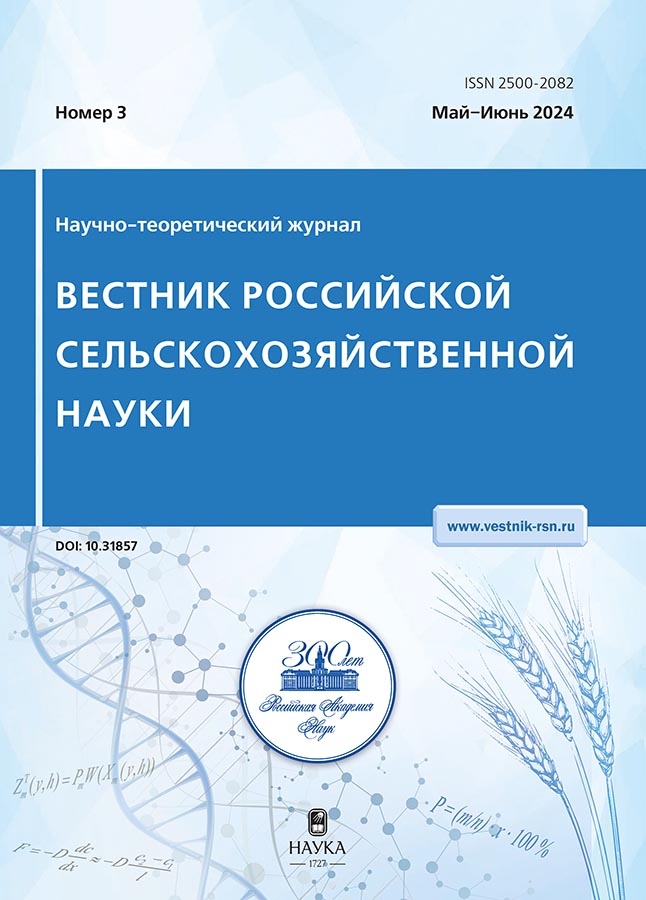Indicators of cow’s milk in the housing and grazing keeping systems
- Authors: Mosolova N.I.1,2, Slozhenkina M.I.1,2, Gorlov I.F.1,2, Kudryashova O.V.1, Tkachenkova N.A.1, Slozhenkina A.A.1
-
Affiliations:
- Volga Region Scientific Research Institute of Meat-and-Milk Production and Processing
- Volgograd State Technical University
- Issue: No 3 (2024)
- Pages: 77-80
- Section: Zootechnics
- URL: https://vietnamjournal.ru/2500-2082/article/view/659329
- DOI: https://doi.org/10.31857/S2500208224030172
- EDN: https://elibrary.ru/ywaiyj
- ID: 659329
Cite item
Abstract
The production of high-quality dairy products is largely influenced by proper provision of optimal conditions for keeping animals. Properly selected conditions for keeping a dairy herd directly affect the strengthening of immunity, productivity and quality of dairy products. The article provides information about pasture and stall conditions for keeping animals with the advantages of pasture keeping in terms of milk productivity and the quality of raw milk. The features of both content systems are briefly summarized. Pasture is most often used in regions with an acceptable climate; stall – mainly in regions with developed agriculture and with limited opportunities for walking livestock on natural pastures. The results of studies of quantitative and qualitative indicators, as well as the nutritional value of milk obtained from Holstein cows kept under pasture and stall systems in two farms in the Volgograd region are presented. From the resulting raw milk, a brief technology for producing samples of a fermented milk product – kefir with lactulose – is shown. Kefir was produced using traditional technology, using a starter culture of kefir grains. The prebiotic carbohydrate lactulose, which has a proven preventive effect, was chosen as an enriching component. Organoleptic, physico-chemical, microbiological parameters, as well as amino acid composition, were studied in samples of the finished product. The results obtained indicate high levels of nutritional and biological value of raw milk and fermented milk products made from it.
Full Text
About the authors
N. I. Mosolova
Volga Region Scientific Research Institute of Meat-and-Milk Production and Processing; Volgograd State Technical University
Author for correspondence.
Email: niimmp@mail.ru
Grand PhD in Biological Sciences
Russian Federation, Volgograd; VolgogradM. I. Slozhenkina
Volga Region Scientific Research Institute of Meat-and-Milk Production and Processing; Volgograd State Technical University
Email: niimmp@mail.ru
Corresponding Member of the RAS
Russian Federation, Volgograd; VolgogradI. F. Gorlov
Volga Region Scientific Research Institute of Meat-and-Milk Production and Processing; Volgograd State Technical University
Email: niimmp@mail.ru
Academician of the RAS
Russian Federation, Volgograd; VolgogradO. V. Kudryashova
Volga Region Scientific Research Institute of Meat-and-Milk Production and Processing
Email: niimmp@mail.ru
PhD in Biological Sciences
Russian Federation, VolgogradN. A. Tkachenkova
Volga Region Scientific Research Institute of Meat-and-Milk Production and Processing
Email: niimmp@mail.ru
PhD Student
Russian Federation, VolgogradA. A. Slozhenkina
Volga Region Scientific Research Institute of Meat-and-Milk Production and Processing
Email: niimmp@mail.ru
Researcher, PhD Student
Russian Federation, VolgogradReferences
- Aminova A.L., Yumaguzin I.F. Effektivnost’ primeneniya bioregulyatorov v zavisimosti ot sistemy i sposoba soderzhaniya korov // Agrarnaya nauka. 2022. № 3. S. 9–13.
- Buyanova I.V, Matyushev V.V., Kuular Ch.G. Tekhnologicheskie osobennosti biokefira s prebioticheskimi veshchestvami // Vestnik KRASGAU. 2022. № 3 (180). S. 148–153.
- Ganushchenko O., Zen’kova N. Perevod korov na pastbishche // Zhivotnovodstvo Rossii. 2022. Aprel’. S. 35–38.
- Ganushchenko O.F. Pravil’nyj perekhod skota na stojlovoe soderzhanie – vazhnyj element upravleniya stadom // Nashe sel’skoe hozyajstvo. 2023. № 18 (314). S. 22–27.
- Zhashuev Zh.H. Vliyanie fitocenoza raznyh gornyh pastbishch na molochnuyu produktivnost’, kachestvo i tekhnologicheskie svojstva moloka // Innovacii i prodovol’stvennaya bezopasnost’. 2018. № 3 (21). S. 121–126.
- Kanochkina M.S., Ivanova L.A., Konovalova A.D. i dr. Osobennosti podbora zakvasochnyh kul’tur v proizvodstve funkcional’nyh kislomolochnyh produktov // Vestnik MGTU. Trudy Murmanskogo gosudarstvennogo tekhnicheskogo universiteta. 2023. T. 26. № 4. S. 511–528.
- Meshcherskih I.A., Lopaeva N.L. Sistemy soderzhaniya krupnogo rogatogo skota // Molodezh’ i nauka. 2023. № 1. S. 36
- Pristupa V.N., Krotova O.E., Kazaryan V.A. i dr. Sravnitel’naya effektivnost’ stojlovo-pastbishchnoj i promyshlennoj tekhnologij soderzhaniya skota // Tekhnika i tekhnologii v zhivotnovodstve. 2023. № 4 (52). S. 29–35.
- Pristupa V.N., Krotova O.E., Lodyanov V.V. i dr. Effektivnost’ stojlovo-pastbishchnoj tekhnologii soderzhaniya cherno-pestrogo i krasnogo stepnogo skota i ee vliyanie na produktivnost’ // Vestnik Ryazanskogo gosudarstvennogo agrotekhnologicheskogo universiteta im. P.A. Kostycheva. 2023. T. 15. № 1. S. 83–89.
- Krasnova I.S., Ganina V.I., Semenov G.V. Fruit and vegetable purees as cryoprotectants for vacuum freeze-dried fermented milk products // Foods and Raw Materials. 2023. T. 11. № 2. S. 300–308.
- Krasnopyorova E., Kanibolotskaya Y., Nazarenko T. Development of technology for a new cottage cheese product with fruit and berry fillers // Vestnik Innovacionnogo Evrazijskogo universiteta. 2022. № 1 (85). S. 158–163.












